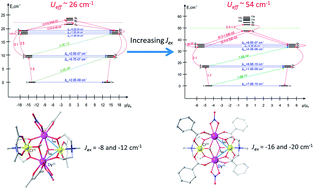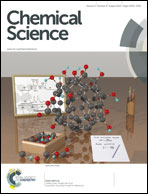Modulation of slow magnetic relaxation by tuning magnetic exchange in {Cr2Dy2} single molecule magnets†
Abstract
A new series of heterometallic 3d–4f single molecule magnets (SMMs) of general formula [CrIII2DyIII2(OMe)2(RN{(CH2)2OH}2)2(acac)4(NO3)2] (R = Me, Et, nBu) is reported, displaying slow relaxation of the magnetization and magnetic hysteresis with non-zero coercive fields. Dynamic magnetic susceptibility experiments show that the three complexes possess anisotropy barriers of 34, 37 and 41 K (24, 29 and 26 cm−1); of similar magnitude to their {CoIII2DyIII2} counterparts. The replacement of the diamagnetic CoIII for paramagnetic CrIII ions results in significantly longer relaxation times, as observed via M(H) hysteresis at low temperatures, absent for the CoIII complexes. The present complexes are also compared to those of a similar CrIII–DyIII complex of formula [CrIII2DyIII2(OMe)2(O2CPh)4(mdea)2(NO3)2] (mdeaH2 = N-methyldiethanolamine), which displays SMM behaviour with a larger anisotropy barrier of 77 K (∼54 cm−1) and even longer relaxation times. We show that the long relaxation times compared to the CoIII analogues are due to the significant magnetic exchange interactions between the CrIII and DyIII ions, resulting in the suppression of quantum tunnelling of the magnetization (QTM) and leading to a multilevel relaxation barrier. The height of the relaxation barrier in these CrIII systems is then shown to be directly related to the strength of the exchange interactions between the CrIII and DyIII ions, showing a clear route towards enhancing the slow magnetic relaxation of coupled CrIII–DyIII systems.


 Please wait while we load your content...
Please wait while we load your content...